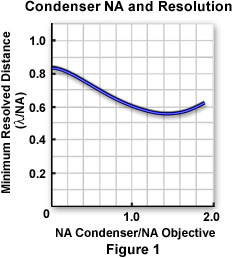Airy Patterns and Resolution Criteria (3-D Version)
Airy Patterns and Resolution Criteria (3-D Version) - Java Tutorial
Airy diffraction pattern sizes and their corresponding radial intensity distribution functions are sensitive to the combination of objective and condenser numerical apertures as well as the wavelength of illuminating light (when monochromatic light is used to illuminate the specimen). For a well-corrected objective with a uniform circular aperture, two adjacent points are just resolved when the centers of their Airy patterns are separated by a minimum distance (D) equal to the radius (r) of the central disk in the Airy pattern. This tutorial explores how Airy disk sizes, at the limit of optical resolution, vary with changes in objective numerical aperture and illumination wavelength, and how these changes affect the resolution (r) and contrast of the objective with regard to the Rayleigh and Sparrow limits as two point images merge together.
The tutorial initializes with the Wavelength slider set to 450 nanometers in the blue color region of the visible light spectrum. Also upon initialization, the virtual Numerical Aperture slider is set to a value of 0.75 and the two Airy patterns are separated by a distance (Degree of Separation slider) of 2.0 micrometers. The light cone size will increase with numerical aperture (at fixed wavelength) and produce a corresponding decrease in the size of the Airy disks (and an increase in resolution). A decrease in wavelength at fixed numerical aperture will result in a decrease in Airy pattern size. Airy patterns are represented in a three-dimensional grid entitled Airy Functions and as an Intensity Plot in a separate window. Beneath the Intensity Plot window is a real-time calculation of image contrast and the Rayleigh resolution criterion according to Abbe diffraction theory. When the two Airy patterns are sufficiently separated so that the Rayleigh and Sparrow criteria are satisfied, this is indicated in boxes positioned beneath the sliders.
To operate the tutorial, use the Wavelength slider to adjust the wavelength of illumination. As this value is decreased, note how the Airy disk size increases along with the Rayleigh distance at fixed numerical aperture. The Numerical Aperture slider can also be used to adjust Airy pattern size by changing the numerical aperture of a virtual microscope objective. As the Airy patterns approach each other, by translation of the Degree of Separation slider, they eventually reach the Rayleigh criterion limit of separation (discussed below), followed by the Sparrow limit and the resulting image loses contrast. This tutorial assumes that virtual objective lenses are completely free of aberrations with Airy patterns that are of identical brightness, and that the unit diffraction pattern generated by the specimen through a circular aperture is in fact an Airy disk. Airy patterns are modified to alternative diffraction patterns by lens aberrations or non-standard aperture conditions.
Objects in the optical microscope that are either self-luminous or illuminated by a large-angle cone of light form Airy patterns at the intermediate image plane that are incoherent and do not interfere with each other. This allows the determination of the minimum separation distance between adjacent Airy patterns by examination of the total intensity distribution (the sum of intensities) when these patterns are closely spaced or overlapping. In the case of Airy patterns produced by coherent illumination, the minimum separation distance must be ascertained by adding the pattern amplitudes rather than their intensities.
When the separation distance (D) between adjacent Airy patterns is greater than the central disk radius (r), the sum of the intensities yields two individual peaks. As the disks approach each other, the separation distance will reach a value equal to the central disk radius, a condition known as the Rayleigh criterion. At even closer approach, the separation distance is less than the central disk radius and the sum of the two peaks merges into a single peak. In the latter instance, the two Airy patterns are said not to be resolved.
In the ideal case, when the objective is aberration-free and provides a uniform circular aperture, two adjacent points are just resolved when the centers of their Airy disks are separated by r (the central Airy disk radius). When the objective numerical aperture matches that of the substage condenser, r is determined from the equation:
r = 1.22λ/2NA(obj)
where λ is the wavelength of light with air as the immersion medium and NA(obj) is the numerical aperture of the objective (and condenser). According to Abbe diffraction theory, the objective numerical aperture is determined by:
NA(obj) = n(sin(θ))
where n is the refractive index of the medium separating the objective front lens and the specimen, and is the half-cone of light captured by the objective. If the specimen is not self-luminous or when the objective and condenser numerical apertures do not match, the equation for r is given by:
r = 1.22λ/(NA(obj) + NA(cond))
where the working numerical aperture of the condenser (NA(cond)) is determined from:
NA(cond) = n(sin(θ))
Figure 1 illustrates the calculated impact of condenser numerical aperture on resolution and includes values where the objective numerical aperture is less than that of the condenser. This figure plots the ratio of the numerical apertures of the condenser and objective versus the minimum resolved distance between Airy patterns (Rayleigh criterion) in units of wavelength divided by the objective aperture.

When two adjacent Airy patterns reach the Rayleigh criterion, the resolution equation reduces to:
D = r = 0.61λ/NA
In cases where two adjacent Airy patterns become closer to each other than in the Rayleigh criterion, the separation is known as the Sparrow limit, which is given by the equation:
D = 0.47λ/NA
As the Degree of Separation slider is adjusted to move the Airy patterns closer together in the tutorial, they eventually fall below the Rayleigh criteria distance, which is noted in the box below the sliders as Unresolved (Rayleigh). Upon even closer approach, the Sparrow limit is superceded, also noted in a similar box to the right (Unresolved (Sparrow)).
对不起,此内容在您的国家不适用。